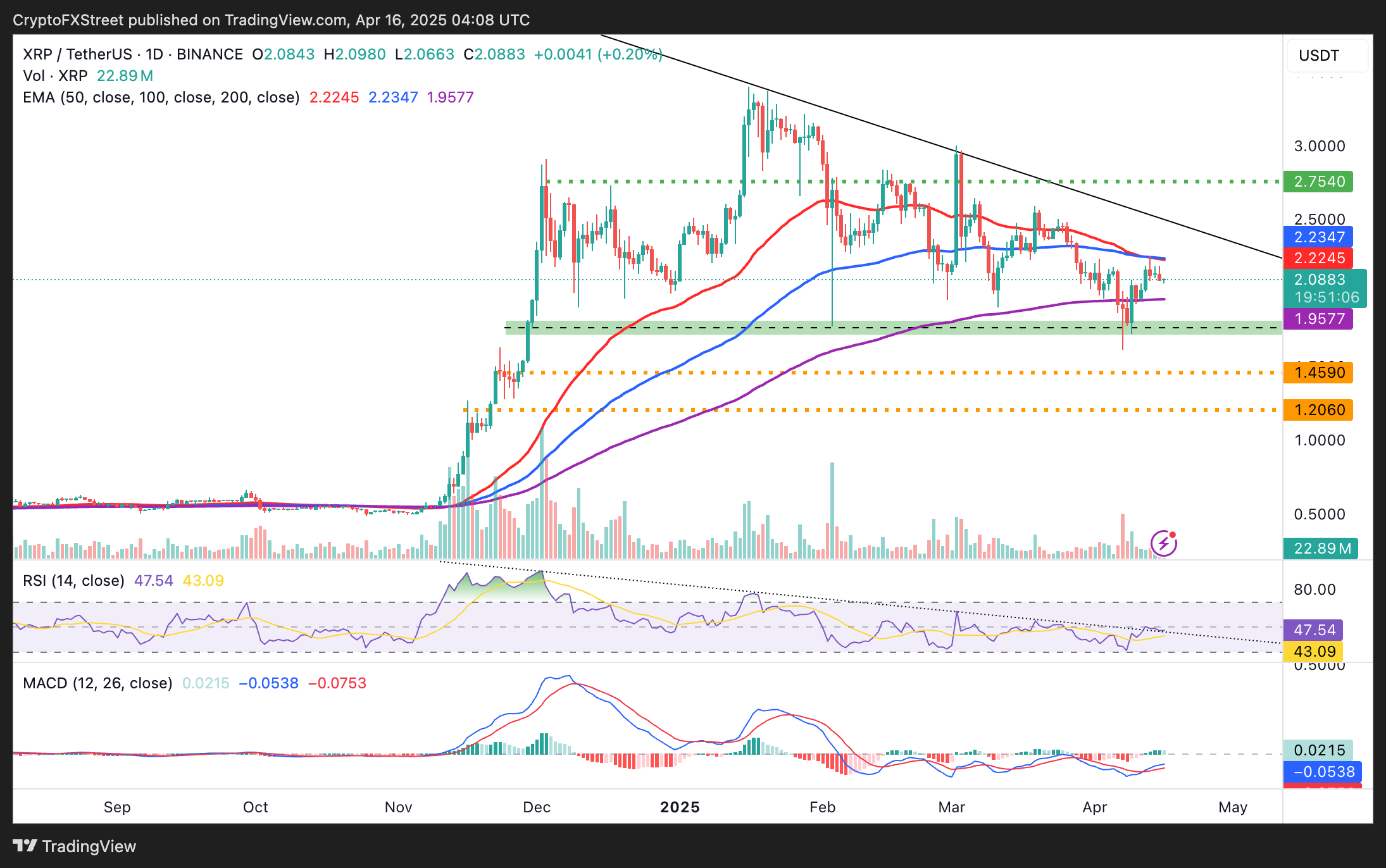- Volatility strikes the crypto market, causing XRP to test the $2.00 support level.
- Exchange inflows soar above 55 million XRP, suggesting investors are preparing to sell the token.
- An increase in long position liquidations to $5.10 million in the past 24 hours suggests traders are reducing their exposure to XRP.
- Improving market dynamics could significantly improve the chances of XRP spot ETF approval – Kaiko Research.
Ripple (XRP) corrected along with other major digital assets, including Bitcoin (BTC) and Ethereum (ETH), and traded at $2.08 at the time of writing on Wednesday. The cross-border money remittance token faces a combination of factors, including global macroeconomic uncertainty, volatility and the apparent increase in exchange inflows. All eyes are on the support at $2.00 which if broken could trigger losses to $1.95 in the short term.
Trade tensions between the United States (US) and China stood out as a major factor, especially after President Donald Trump’s administration banned exports of H20 chips to the Asian economic giant—a move likely to hit NVIDIA’s financial status by $5.5 billion in the company’s fiscal first quarter, ending April 27.
The US stock market resumed the correction after a week of sustained gains, with S&P futures falling by 0.85%, Dow futures by 0.33% and Nasdaq futures by 1.42%.
Soaring exchange inflows trigger volatility
XRP edged higher from the middle of last week as traders made a comeback buoyed by sentiment hinged on President Trump pausing tariffs for 90 days, except for China. The token reclaimed the critical $2.00 level before advancing to $2.25, accentuated by news that Ripple’s CEO Brad Garlinghouse had reached an agreement with the Securities and Exchange Commission (SEC) staff over the settlement and dismissal of the long-standing lawsuit.
As reported on Tuesday, following the agreement, the staff is expected to make recommendations to the agency’s commissioners, who will vote on the matter.
Meanwhile, XRP experienced a spike in liquidity during the Asian session on Wednesday, caused by, among other factors, a surge in exchange inflows from 28 million on April 8 to 55.6 million XRP on Wednesday, per CryptoQuant data.

XRP exchange inflow data | Source: CryptoQuant
When investors deposit tokens on exchanges, it signals potential selling pressure, likely driving the price down. The surge could also correlate with a spike in whale-to-exchange transactions and prevailing market sentiment, which is shaky and worth watching.
Liquidation data from Coinglass could help shape the direction of market sentiment, especially with $5.1 million wiped out in long positions compared to $1.25 million in short positions in the last 24 hours. Moreover, a negative long-to-short ratio of 0.938 suggests that investors prefer to reduce exposure to XRP, possibly expecting more retracement.

XRP derivatives data | Source: Coinglass
Can XRP bulls defend $2.00 support?
The XRP price hovers at $2.08 at the time of writing. After extending the gap from the confluence resistance, bulls have been fighting to break at $2.24, formed by the 50-day and 100-day Exponential Moving Averages (EMA). If XRP loses the immediate $2.00 support, losses could extend to the 200-day EMA at $1.95 and the next support area at $1.61, tested on Monday last week.

XRP/USD daily chart
Despite the drawdown, the Moving Average Convergence Divergence (MACD) indicator upholds a buy signal, reinforced by green histograms. The Relative Strength Index (RSI) indicator could signal where XRP is heading, with a sustained move above the descending trend affirming the bullish grip. At the same time, movement toward the oversold region would suggest that the trend is flipping bearish.
The potential approval of XRP ETF applications is a key factor likely to shape XRP’s price trend in 2025. However, investors must temper their expectations, considering that soon-to-be-sworn-in SEC Chair Paul Atkins might delay the process as he gets acquainted with his new role.
According to Kaiko Research, “May 22 is an important date to watch in light of the recent ETF approval of a 2x XRP ETF from Teucrium, as the SEC must respond to Grayscale’s XRP spot filing by then.”
Kaiko outlined in the report that XRP ETFs are more likely to be approved than Solana ETFs, thanks to the token’s significantly improved market depth since the end of 2024.
Crypto ETF FAQs
An Exchange-Traded Fund (ETF) is an investment vehicle or an index that tracks the price of an underlying asset. ETFs can not only track a single asset, but a group of assets and sectors. For example, a Bitcoin ETF tracks Bitcoin’s price. ETF is a tool used by investors to gain exposure to a certain asset.
Yes. The first Bitcoin futures ETF in the US was approved by the US Securities & Exchange Commission in October 2021. A total of seven Bitcoin futures ETFs have been approved, with more than 20 still waiting for the regulator’s permission. The SEC says that the cryptocurrency industry is new and subject to manipulation, which is why it has been delaying crypto-related futures ETFs for the last few years.
Yes. The SEC approved in January 2024 the listing and trading of several Bitcoin spot Exchange-Traded Funds, opening the door to institutional capital and mainstream investors to trade the main crypto currency. The decision was hailed by the industry as a game changer.
The main advantage of crypto ETFs is the possibility of gaining exposure to a cryptocurrency without ownership, reducing the risk and cost of holding the asset. Other pros are a lower learning curve and higher security for investors since ETFs take charge of securing the underlying asset holdings. As for the main drawbacks, the main one is that as an investor you can’t have direct ownership of the asset, or, as they say in crypto, “not your keys, not your coins.” Other disadvantages are higher costs associated with holding crypto since ETFs charge fees for active management. Finally, even though investing in ETFs reduces the risk of holding an asset, price swings in the underlying cryptocurrency are likely to be reflected in the investment vehicle too.

























